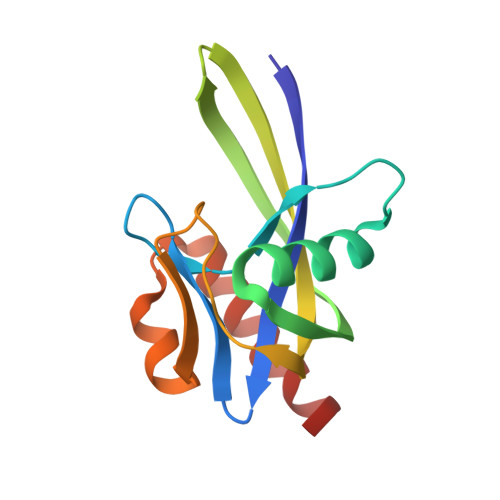Free and ATP-bound structures of Ap(4)A hydrolase from Aquifex aeolicus V5
Jeyakanthan, J., Kanaujia, S.P., Nishida, Y., Nakagawa, N., Praveen, S., Shinkai, A., Kuramitsu, S., Yokoyama, S., Sekar, K.(2010) Acta Crystallogr D Biol Crystallogr 66: 116-124
- PubMed: 20124691
- DOI: https://doi.org/10.1107/S0907444909047064
- Primary Citation of Related Structures:
3I7U, 3I7V - PubMed Abstract:
Asymmetric diadenosine tetraphosphate (Ap(4)A) hydrolases degrade the metabolite Ap(4)A back into ATP and AMP. The three-dimensional crystal structure of Ap(4)A hydrolase (16 kDa) from Aquifex aeolicus has been determined in free and ATP-bound forms at 1.8 and 1.95 A resolution, respectively. The overall three-dimensional crystal structure of the enzyme shows an alphabetaalpha-sandwich architecture with a characteristic loop adjacent to the catalytic site of the protein molecule. The ATP molecule is bound in the primary active site and the adenine moiety of the nucleotide binds in a ring-stacking arrangement equivalent to that observed in the X-ray structure of Ap(4)A hydrolase from Caenorhabditis elegans. Binding of ATP in the active site induces local conformational changes which may have important implications in the mechanism of substrate recognition in this class of enzymes. Furthermore, two invariant water molecules have been identified and their possible structural and/or functional roles are discussed. In addition, modelling of the substrate molecule at the primary active site of the enzyme suggests a possible path for entry and/or exit of the substrate and/or product molecule.
Organizational Affiliation:
Life Science Group, National Synchrotron Radiation Research Center, 101 Hsin-Ann Road, Hsinchu Science Park, Hsinchu 30076, Taiwan.






















